七年级英语上册Module 6 Unit 1 Does it eat meat教案 新版外研版
- 格式:doc
- 大小:120.00 KB
- 文档页数:5

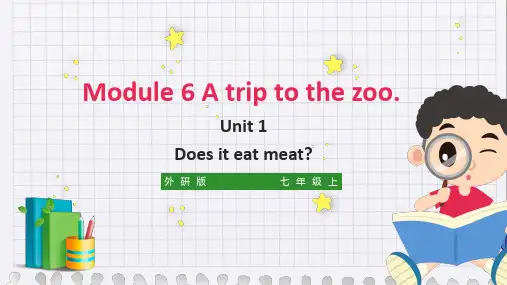
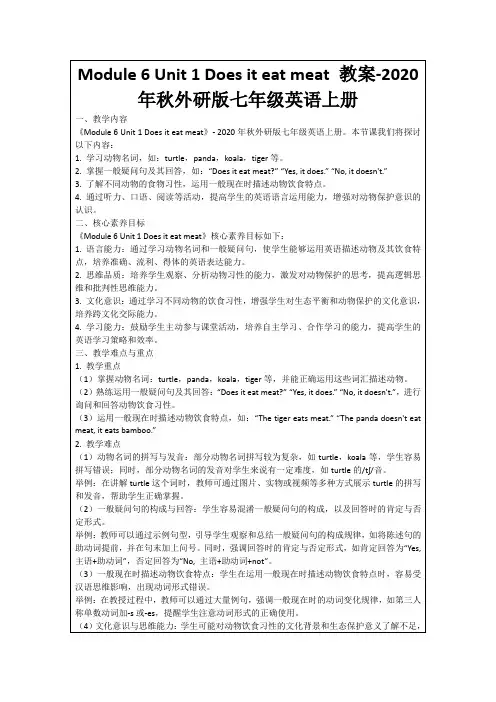
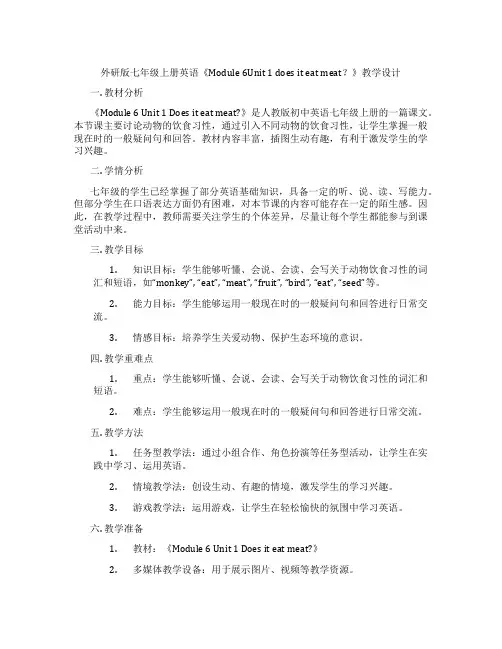
外研版七年级上册英语《Module 6Unit 1 does it eat meat?》教学设计一. 教材分析《Module 6 Unit 1 Does it eat meat?》是人教版初中英语七年级上册的一篇课文。
本节课主要讨论动物的饮食习性,通过引入不同动物的饮食习性,让学生掌握一般现在时的一般疑问句和回答。
教材内容丰富,插图生动有趣,有利于激发学生的学习兴趣。
二. 学情分析七年级的学生已经掌握了部分英语基础知识,具备一定的听、说、读、写能力。
但部分学生在口语表达方面仍有困难,对本节课的内容可能存在一定的陌生感。
因此,在教学过程中,教师需要关注学生的个体差异,尽量让每个学生都能参与到课堂活动中来。
三. 教学目标1.知识目标:学生能够听懂、会说、会读、会写关于动物饮食习性的词汇和短语,如“monkey”, “eat”, “meat”, “fruit”, “bird”, “eat”, “seed”等。
2.能力目标:学生能够运用一般现在时的一般疑问句和回答进行日常交流。
3.情感目标:培养学生关爱动物、保护生态环境的意识。
四. 教学重难点1.重点:学生能够听懂、会说、会读、会写关于动物饮食习性的词汇和短语。
2.难点:学生能够运用一般现在时的一般疑问句和回答进行日常交流。
五. 教学方法1.任务型教学法:通过小组合作、角色扮演等任务型活动,让学生在实践中学习、运用英语。
2.情境教学法:创设生动、有趣的情境,激发学生的学习兴趣。
3.游戏教学法:运用游戏,让学生在轻松愉快的氛围中学习英语。
六. 教学准备1.教材:《Module 6 Unit 1 Does it eat meat?》2.多媒体教学设备:用于展示图片、视频等教学资源。
3.教学卡片:用于单词和短语的学习。
4.任务单:用于小组合作和讨论。
七. 教学过程1.导入(5分钟)教师通过向学生展示不同动物的图片,引导学生谈论动物,为新课的学习营造轻松愉快的学习氛围。
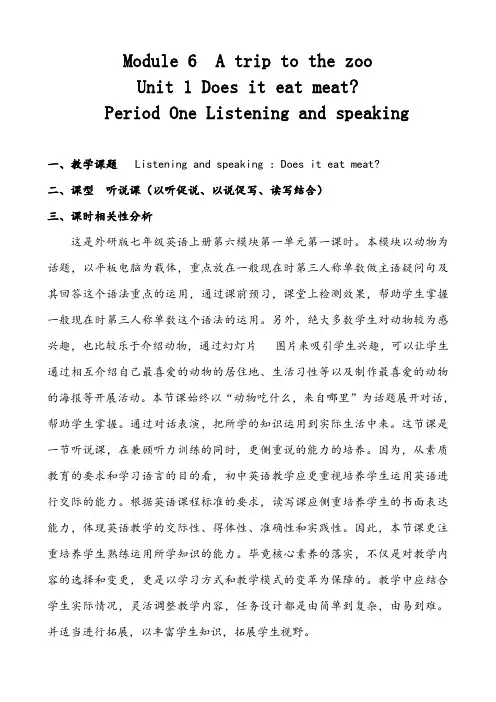
Module 6 A trip to the zooUnit 1 Does it eat meat?Period One Listening and speaking一、教学课题Listening and speaking :Does it eat meat?二、课型听说课(以听促说、以说促写、读写结合)三、课时相关性分析这是外研版七年级英语上册第六模块第一单元第一课时。
本模块以动物为话题,以平板电脑为载体,重点放在一般现在时第三人称单数做主语疑问句及其回答这个语法重点的运用,通过课前预习,课堂上检测效果,帮助学生掌握一般现在时第三人称单数这个语法的运用。
另外,绝大多数学生对动物较为感兴趣,也比较乐于介绍动物,通过幻灯片图片来吸引学生兴趣,可以让学生通过相互介绍自己最喜爱的动物的居住地、生活习性等以及制作最喜爱的动物的海报等开展活动。
本节课始终以“动物吃什么,来自哪里”为话题展开对话,帮助学生掌握。
通过对话表演,把所学的知识运用到实际生活中来。
这节课是一节听说课,在兼顾听力训练的同时,更侧重说的能力的培养。
因为,从素质教育的要求和学习语言的目的看,初中英语教学应更重视培养学生运用英语进行交际的能力。
根据英语课程标准的要求,读写课应侧重培养学生的书面表达能力,体现英语教学的交际性、得体性、准确性和实践性。
因此,本节课更注重培养学生熟练运用所学知识的能力。
毕竟核心素养的落实,不仅是对教学内容的选择和变更,更是以学习方式和教学模式的变革为保障的。
教学中应结合学生实际情况,灵活调整教学内容,任务设计都是由简单到复杂,由易到难。
并适当进行拓展,以丰富学生知识,拓展学生视野。
四、学情分析通过以前小学的学习,学生可能已熟悉部分常见简单的表示动物的英语名称。
本模块则是进一步学习有关动物的名称的基础上引入到谈论自己最喜爱的动物以及它的居住地、生活习性等的话题上,这是学生很熟悉也是很感兴趣的话题。
这节课,学生们运用了平板电脑,云课堂app和葵花籽 app 等新媒体技术。

Unit 1Does it eat meat?◇目标导航◇类别课时要点重点单词bear n.熊elephant n.大象giraffe n.长颈鹿lion n.狮子monkey n.猴子panda n.熊猫tiger n.老虎zebra n.斑马zoo n.动物园guide n.导游animal n.动物such adj.这样的;如此的as prep.像……一样come v.来different adj.不同的country n.国家other adj.其他的dangerous adj.危险的教学重点 1.本单元任务3对话部分的听、说、读以及分角色表演。
2.会用英语谈论自己喜爱的动物。
教学难点 会用英语谈论自己喜爱的动物。
◇教学过程◇一、方法指导1.自主预习教材P36~37中的新单词(见词汇表P93~94),掌握词形及汉语意思。
2.预习课文任务3中的对话,能自主朗读对话并翻译对话中的句子。
二、预习检测Ⅰ.汉译英 1.动物园 zoo 2.熊 bear 3.长颈鹿 giraffe 4.狮子 lion 5.猴子 monkey6.老虎 tiger7.熊猫 panda8.斑马 zebra 9.大象 elephant10.动物 animal 11.植物 plant12.竹子 bamboo 13.导游 guide14.国家 country 15.其他的 other16.危险的 dangerous 17.高的 tall 18.可爱的 cute19.有趣的 funny 20.不同的 differentⅡ.根据汉语意思完成句子,每空一词1.欢迎到北京动物园来。
Welcome to Beijing Zoo.2.他们来自许多不同的国家。
They come from many different countries.3.我们去看看他们好吗?Shall we go and see them?4.它们是我最喜爱的动物。
They are my favourite animals.5.有个名叫托尼的熊猫吗?Is there a panda called Tony?6.那非常有趣。
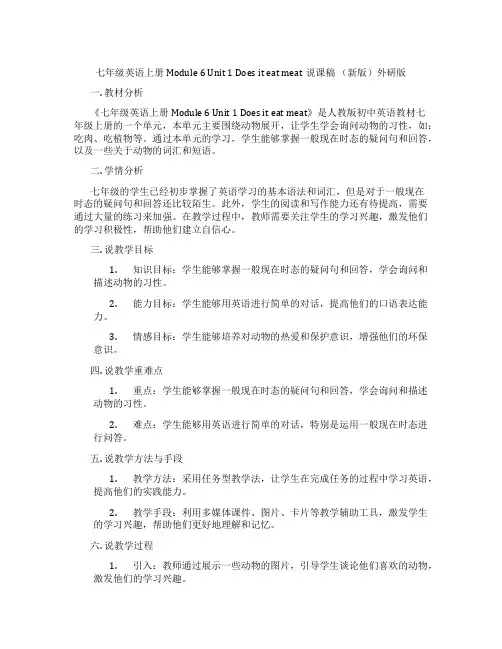
七年级英语上册 Module 6 Unit 1 Does it eat meat说课稿(新版)外研版一. 教材分析《七年级英语上册 Module 6 Unit 1 Does it eat meat》是人教版初中英语教材七年级上册的一个单元,本单元主要围绕动物展开,让学生学会询问动物的习性,如:吃肉、吃植物等。
通过本单元的学习,学生能够掌握一般现在时态的疑问句和回答,以及一些关于动物的词汇和短语。
二. 学情分析七年级的学生已经初步掌握了英语学习的基本语法和词汇,但是对于一般现在时态的疑问句和回答还比较陌生。
此外,学生的阅读和写作能力还有待提高,需要通过大量的练习来加强。
在教学过程中,教师需要关注学生的学习兴趣,激发他们的学习积极性,帮助他们建立自信心。
三. 说教学目标1.知识目标:学生能够掌握一般现在时态的疑问句和回答,学会询问和描述动物的习性。
2.能力目标:学生能够用英语进行简单的对话,提高他们的口语表达能力。
3.情感目标:学生能够培养对动物的热爱和保护意识,增强他们的环保意识。
四. 说教学重难点1.重点:学生能够掌握一般现在时态的疑问句和回答,学会询问和描述动物的习性。
2.难点:学生能够用英语进行简单的对话,特别是运用一般现在时态进行问答。
五. 说教学方法与手段1.教学方法:采用任务型教学法,让学生在完成任务的过程中学习英语,提高他们的实践能力。
2.教学手段:利用多媒体课件、图片、卡片等教学辅助工具,激发学生的学习兴趣,帮助他们更好地理解和记忆。
六. 说教学过程1.引入:教师通过展示一些动物的图片,引导学生谈论他们喜欢的动物,激发他们的学习兴趣。
2.新课呈现:教师通过课件展示本节课的主要内容,让学生初步了解一般现在时态的疑问句和回答,以及关于动物的词汇和短语。
3.实践环节:教师学生进行小组活动,让他们用英语询问和描述动物的习性,练习一般现在时态的问答。
4.巩固环节:教师通过游戏、练习等方式,让学生进一步巩固本节课所学内容。
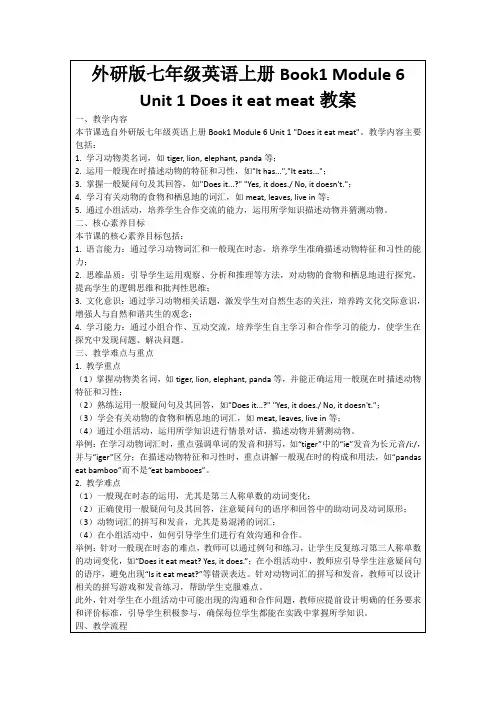
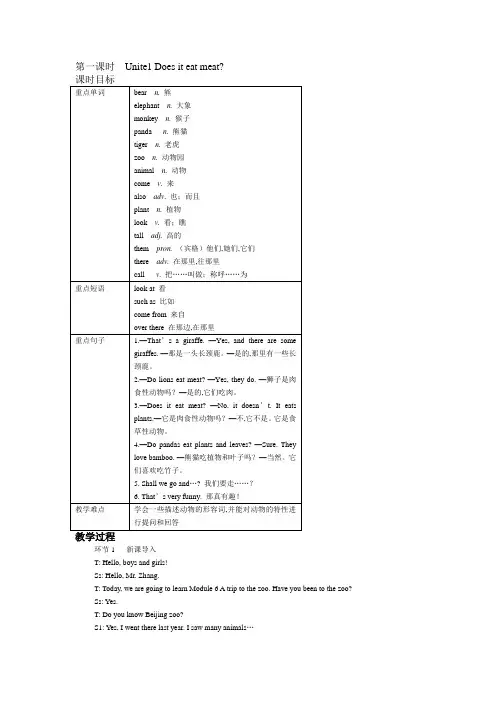
第一课时Unite1 Does it eat meat?环节1 新课导入T: Hello, boys and girls!Ss: Hello, Mr. Zhang.T: Today, we are going to learn Module 6 A trip to the zoo. Have you been to the zoo?Ss: Yes.T: Do you know Beijing zoo?S1: Yes, I went there last year. I saw many animals…S2:…T: OK. Today I’ll take you to visit Beijing zoo. Are you happy?Ss: Yes.T: Please look at the screen and get to know some information about Beijing Zoo.Ss: …(Look at the screen and try to know some information about it.)设计意图:以图片的形式进行直观教学,能很快导入课文,抓住学生的好奇心,吸引学生的学习兴趣。
环节2 学习1-81.教师给出一副图的某一部分,让学生猜出是什么动物,以此引入动物名词。
2.听活动2的录音,让学生勾出所听到的活动1中的单词。
3.听活动3的录音,完成表格。
4.核对答案。
再听一遍录音,让学生勾出文中重要的词汇和句子。
教师对文中的难句和知识点进行讲解。
5.让学生完成活动4 的任务。
教师核对答案。
6.听活动5和活动6的录音,让学生跟读,并完成相应任务。
7.让学生结对根据活动3短文中对动物的描述进行提问和回答。
8.让学生结对编写关于动物的对话,并抽取2-3组学生当堂进行表演。
9.学以致用。
根据首字母提示写出单词(1)Beijing Zoo has many kinds of a______.(2)The lions are d__________ because they eat meat.(3)Pandas are black and white and eat b__________.(4)The b_______ eat meat and plants.(5)An e__________ is tall and eats plants.Answers:(1)animals (2)dangerous (3)bamboo (4)bears (5)elephant设计意图:引导学生运用结对练习法进行初步的语言实践,鼓励学生大胆开口,培养学生运用目标语言进行交际的能力。
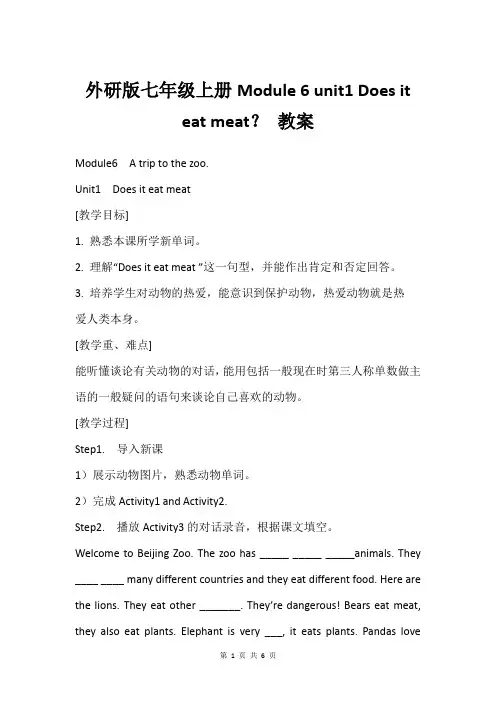
外研版七年级上册Module 6 unit1 Does iteat meat?教案Module6 A trip to the zoo.Unit1 Does it eat meat[教学目标]1. 熟悉本课所学新单词。
2. 理解“Does it eat meat ”这一句型,并能作出肯定和否定回答。
3. 培养学生对动物的热爱,能意识到保护动物,热爱动物就是热爱人类本身。
[教学重、难点]能听懂谈论有关动物的对话,能用包括一般现在时第三人称单数做主语的一般疑问的语句来谈论自己喜欢的动物。
[教学过程]Step1. 导入新课1)展示动物图片,熟悉动物单词。
2)完成Activity1 and Activity2.Step2. 播放Activity3的对话录音,根据课文填空。
Welcome to Beijing Zoo. The zoo has _____ _____ _____animals. They ____ ____ many different countries and they eat different food. Here are the lions. They eat other _______. They’re dangerous! Bears eat meat, they also eat plants. Elephant is very ___, it eats plants. Pandas love_______. They are ____.Step3. Repeat the conversation and complete the table in Activity3. Step4. Work in pairs(Activity3).Step5. Read the conversation together and underline the correct words in Activity4.Step6. 知识点拨1. Does it eat meat 它吃肉吗?此句的主语是it,是第三人称单数,故在一般疑问句中用了助动词does,且动词用原形。
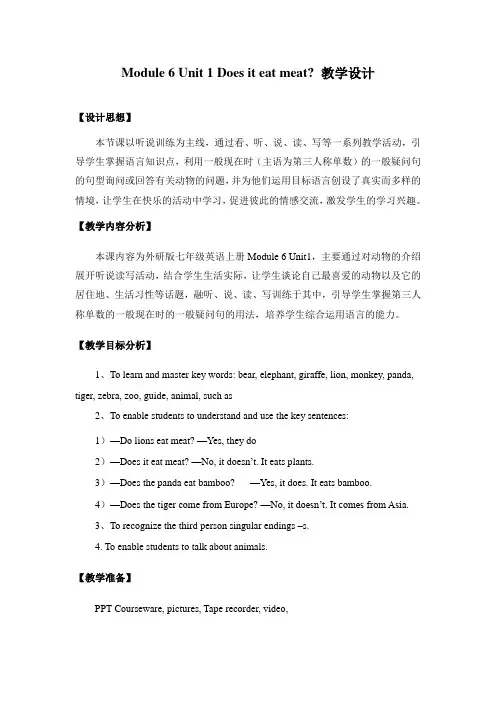
Module 6 Unit 1 Does it eat meat? 教学设计【设计思想】本节课以听说训练为主线,通过看、听、说、读、写等一系列教学活动,引导学生掌握语言知识点,利用一般现在时(主语为第三人称单数)的一般疑问句的句型询问或回答有关动物的问题,并为他们运用目标语言创设了真实而多样的情境,让学生在快乐的活动中学习,促进彼此的情感交流,激发学生的学习兴趣。
【教学内容分析】本课内容为外研版七年级英语上册Module 6 Unit1,主要通过对动物的介绍展开听说读写活动,结合学生生活实际,让学生谈论自己最喜爱的动物以及它的居住地、生活习性等话题,融听、说、读、写训练于其中,引导学生掌握第三人称单数的一般现在时的一般疑问句的用法,培养学生综合运用语言的能力。
【教学目标分析】1、To learn and master key words: bear, elephant, giraffe, lion, monkey, panda, tiger, zebra, zoo, guide, animal, such as2、To enable students to understand and use the key sentences:1)—Do lions eat meat? —Yes, they do2)—Does it eat meat? —No, it doesn’t. It eats plants.3)—Does the panda eat bamboo? —Yes, it does. It eats bamboo.4)—Does the tiger come from Europe? —No, it doesn’t. It comes from Asi a.3、To recognize the third person singular endings –s.4. To enable students to talk about animals.【教学准备】PPT Courseware, pictures, Tape recorder, video,【教学过程设计】Step 1 Lead-in1) Show some pictures to ask and answer: What can you see?2) Let students watch a video about animals ,and talk with students.设计意图:通过展示动物图片进行师生间的简单对话互动,引出本课教学内容,利用多媒体课件视频,创设真实参观动物园的情境,增加学生的学习兴趣,让他们在轻松愉快的气氛中自然进入本课的学习。
Unit 1 Does it eat meatA: Hi, Bob. A new zoo in our city is open. There are different animals from other countries, such as bears, elephants, tigers, lions, monkeys…B: Do they have giraffes and zebras?A: Sure! Do you like them?B: Yes. They are funny and tall. They are also not dangerous and they eat plants. A: Why not go and see them in the zoo?B: Good idea! Shall we go now?A: Let’s go.(Thirty minutes later, they get to the zoo.)B: Look at the zoo map. Which animals do you want to see first?A: Pandas. They come from China. They eat bamboo. They only live in China. They are so cute. Chinese people call them “national treasure(国宝)”.B: You know so much.A: Thanks. Ugh! The guide is over there. Let’s go and meet her.1. bear n.熊2. elephant n. 大象3. giraffe n.长颈鹿4. lion n. 狮子5. monkey n.猴子6. panda n.熊猫7. tiger n. 老虎8. zebra n. 斑马9. zoo n. 动物园10. guide n.导游11. animal n.动物12. such adj.这样的;如此的13. as prep.像……一样14. come v.来15. different adj. 不同的16. country n.国家【新义:n. 乡下;农村】17. other adj. 其他的【新义:pron. 另外;其他;另一个】18. dangerous adj. 危险的19. ugh int.啊,哎呀20. also adv.也;而且21. plant n. 植物【新义:v.种植】22. look v.看,瞧23. tall adj.高的24. sure adv.的确,当然25. bamboo n.竹子26. cute adj. 可爱的27. shall v.aux. ……好吗?要不要……?28. them pron. (宾格)他们,她们,它们29. which pron.哪一个30. over prep. 在……的上方31. there adv.在那里,往那里32. funny adj.有趣的33. call v. 把……叫做;称呼……为1. different adj.不同的→ difference n. 差别;差异2. country n. 国家复数 countries3. dangerous adj. 危险的→ danger n. 危险4. them pron.(宾格)他们,她们,它们主格 they1. such as 比如2. come from 来自3. look at 看4. over there 在那边,在那里5. in front of 在……的前面6. black and white 黑白相间的7. welcome to…欢迎来到……1. 动物园里有各种各样的动物,比如:熊,斑马,长颈鹿和熊猫。
外研版七年级上册(新标准)《Module 6Unit 1 does it eat meat?》说课稿一. 教材分析《Module 6 Unit 1 Does it eat meat?》是人教版七年级上册(新标准)英语教材中的一课。
本节课主要讨论动物的饮食习性,通过引入不同动物的饮食习性,让学生学会使用一般现在时提问和回答动物的饮食习性。
教材内容丰富,贴近学生生活,有利于激发学生的学习兴趣。
二. 学情分析七年级的学生已经掌握了基本的英语语法和词汇,具备一定的听说读写能力。
但学生在使用一般现在时态提问和回答问题方面还存在一定的困难。
因此,在教学过程中,教师需要关注学生的学习需求,帮助学生掌握一般现在时态的用法。
三. 说教学目标1.知识目标:学生能够掌握一般现在时态的疑问句和回答方式,学会用英语描述动物的饮食习性。
2.能力目标:学生能够在真实情境中运用一般现在时态进行交流,提高英语表达能力。
3.情感目标:培养学生热爱动物,关注动物生活的情感态度。
四. 说教学重难点1.重点:一般现在时态的疑问句和回答方式。
2.难点:一般现在时态在实际情境中的运用。
五. 说教学方法与手段1.教学方法:采用任务型教学法,情境教学法和分组合作学习法,激发学生的学习兴趣,提高学生的参与度。
2.教学手段:利用多媒体课件、图片、卡片等辅助教学,创设真实情境,帮助学生更好地理解和运用语言。
六. 说教学过程1.导入:通过展示不同动物的图片,引导学生谈论动物,为新课的学习做好铺垫。
2.呈现:介绍一般现在时态的疑问句和回答方式,让学生感知和理解语言现象。
3.实践:分组讨论不同动物的饮食习性,用一般现在时态进行提问和回答。
4.巩固:通过小组竞赛、游戏等活动,让学生在真实情境中运用一般现在时态。
5.拓展:引导学生运用一般现在时态描述日常生活中的事物,提高学生的语言运用能力。
6.总结:对本节课的主要内容进行总结,强调一般现在时态的疑问句和回答方式。
外研版七年级上册(新标准)《Module 6Unit 1 does it eat meat?》教学设计一. 教材分析《Module 6 Unit 1 Does it eat meat?》是人教版新标准英语七年级上册的一篇文章,主要讨论了动物的饮食习性。
文章通过介绍不同动物的饮食习性,引导学生学会使用一般现在时进行问答。
本课的主要语言点是一般现在时的特殊疑问句和简略回答。
通过本课的学习,学生能够掌握一般现在时的基本用法,并能运用所学知识进行日常交流。
二. 学情分析七年级的学生已经具备了一定的英语基础,对于一般现在时已经有了一定的了解。
但是,学生在语言运用方面还存在一定的问题,如发音不准确,词汇量不足等。
因此,在教学过程中,教师需要注重学生的发音训练和词汇积累,同时激发学生的学习兴趣,提高他们的学习积极性。
三. 教学目标1.知识目标:学生能够掌握一般现在时的特殊疑问句和简略回答,了解不同动物的饮食习性。
2.能力目标:学生能够运用一般现在时进行日常交流,提高口语表达能力。
3.情感目标:培养学生热爱动物,保护动物的意识。
四. 教学重难点1.重点:一般现在时的特殊疑问句和简略回答。
2.难点:一般现在时的运用和动物饮食习性的理解。
五. 教学方法采用任务型教学法,通过情境创设,激发学生的学习兴趣,引导学生主动参与课堂活动,提高学生的口语表达能力。
六. 教学准备1.教学课件:制作课件,包括图片、视频等教学资源。
2.教学道具:准备与动物相关的实物或图片。
3.教学环境:布置课堂环境,营造轻松愉快的学习氛围。
七. 教学过程1.导入(5分钟)教师通过展示不同动物的图片,引导学生谈论动物的特点,激发学生的学习兴趣。
2.呈现(10分钟)教师展示文章标题“Does it eat meat?”,引导学生猜测文章内容。
然后,教师播放文章动画视频,让学生初步感知文章内容。
3.操练(10分钟)教师引导学生跟读文章,注意纠正发音。
然后,教师挑选几名学生进行角色扮演,模仿文章中的对话。
Book1Module6Atriptothezoo一、教学内容:Unit1Doesiteatmeat?二、课型:Listeningandspeaking三、教学目标:语言目标(1)Tohelpstudentsmasterthewords,如:elephant,giraffe,kangaroo,lion,monkey,pan da,polarbear,,ti ger,wolf,zebra,bamboo,there,suchas,leaf-leaves,dangerous.(2)Tohelpstudentsmasterthesentences如:①Doesiteatmeat?Yes,itdoes.No,itdoesn’t.能力目标(1)Tounderstandandgetmoredetailedinformationaboutanimalsfromlisteningandreading.(2)Toaskandanswerquestionsaboutthehabitatandthefoodofdifferentanimals.(3)Totalkabouttheirfavouriteanimal.情感目标Studentscanloveandprotectanimalsfromlearning。
四、教学重难点:重点:(1)重点句型:一般现在时(主语第三人称单数)的一般疑问句以及肯定和否定形式。
(2)重点话题:Talkaboutone’sfavouriteanimal.难点:(1)掌握一般现在时(主语第三人称单数)的一般疑问句以及肯定和否定形式。
(2)能用恰当地道的英语问答有关动物的问题以及介绍自己的最喜爱的动物。
五、教学准备:本次课堂为听说课,主要采用互动式教学法,创设真实语境,通过个人呈现,同伴互动,小组活动等师生、生生的交流,充分体现了学生在学习过程中的主体地位,教师只是课堂的引导者,组织者和合作者,让学生在使用中学会英语,综合培养学生的英语语言运用能力。
Module 6 A trip to the zooUnit 1 Does it eat meat?一.短语:1.欢迎来到__________________2.让我们____________3.例如(列举)______________4.来自_______________5.在……的前面______________6.在那边_______________7.在那里,在那边____________ 8.看_______________9.…是危险的/可爱的/有趣的___________________________二.知识归纳:1.(例句)Welcome to Beijing Zoo.欢迎来到北京动物园。
【归纳】welcome +to+________, 意为“_____________”.(例句)welcome home.【归纳】welcome后接__________,要省略介词______.Exercise: 同学们,欢迎来到希望公园。
Everybody,_______ ______ Hope pa rk.2. (例句) They eat other animals. 他们吃其他的动物She has two brothers. One is a doctor, and the other is a teacher.她有两个哥哥,一个是医生,另一个是老师。
I don’t like this one .Please give me another one.我不喜欢这个,请给我另一个。
【归纳】(1)other意为___________,后接______________. (2)the other意为____________, 表示特指。
(3)another意为_______,表示三者或三者以上的另一个,或不确定数量的另一个,表泛指。
Exercise :(1)Have you got any ______ novels?A.anotherB.other C .the other(2)My family has two dogs. One is white, and ______ is black.A.anotherB.other C .the other3. (例句) Is there a panda called Tony…..?有叫托尼的熊猫吗…..?Is there a boy called Xiaoming …..? 有叫小明的男孩吗?【归纳】 Is there ….. called …..?意为___________________,called To ny为过去分词短语作后置定语,修饰前面的名词.Exercise : I like reading books ______ by Luxun.A. writeB. wroteC. written三.针对性训练( )1.Here ____your books.A. isB.amC.are( )2.Where _____ the tiger come from?—It _____ from Europe.A.do,comesB.does,comeC.does ,comes( )3.Could I have _____ cake?A.anotherB.other C .the other4.The panda eats plants.(改为否定句和一般疑问句)The panda _____ _____ plants._____ the panda ______ plants?5.Lily is from America.(同义句)Lily ______ ______ Amer ica./ Lily ____ ________.6.今天下午我们去购物好吗?_____ _____ _____ shopping this afternoon?2。
Module 6 A trip to the zoo一、学习目标:1. 重点单词:bear, elephant, giraffe, lion, monkey, panda, tiger, zebra, zoo, guide, animal, such, as, come, different, country, other, dangerous, ugh, also, plant, look, tall, leaf (pl. leaves), sure, bamboo, cute, shall, them, which, over, funny, call, Africa, Asia, Europe, little, only, about, kilo (= kilogram ), people, African, grass, large, usually, alone, strong, catch, even2. 重点短语:such as, come from, look at, over there, a little, all over the world, as well as, be good at, many kinds of3.重点句子:1.— That’s a giraffe.— Yes, and there are some giraffes2.—Do lions eat meat?—Yes, they do.3.—Does it eat meat?—No, it doesn’t. It eats plants.4.—Do pandas eat plants and leaves?—Sure. They love bamboo.5. Shall we go and…?6. That’s very funny.7. It doesn’t eat meat.8. The tiger lives in Asia.二、重点及难点:Present simple questions.三、教学设计:Unit 1 Does it eat meat?ⅠTeaching modelListening and speakingⅡTeaching methodInteractive approachⅢTeaching aims1. To find specific information in the listening.2. To recognize the third person singular endings –s.3. To ask and answer questions about animals.4. To enable students to talk about animals.ⅣTeaching ObjectivesKey vocabulary: bear, elephant, giraffe, lion, monkey, panda, tiger, zebra, zoo, guide, animal, such, as, come, different, country, other, dangerous,ugh, also, plant, look, tall, leaf (pl. leaves), sure, bamboo, cute,shall, them, which, over, funny, callKey structures:1.— That’s a giraffe. — Yes, and there are some giraffes2.—Do lions eat meat? —Yes, they do.3.—Does it eat meat? —No, it doesn’t. It eats plants.4.—Do pandas eat plants and leaves? —Sure. They love bamboo.5. Shall we go and…?6. That’s very funny.ⅤTeaching aidsTape recorder , OHP , video , a clockⅥTeaching StepsStep 1 Warming-up1. Lead inT: Hello, boys and girls!Ss: Hello, Mr. Zhang.T: Today, we are going to learn Module 6 A trip to the zoo. Have you been to the zoo?Ss: Yes.T: Do you know Beijing zoo?S1: Yes, I went there last year. I saw many animals…S2:…T: OK. Today I’ll take you to visit Beijing zoo. Are you happy?Ss: Yes.T: Please look at the screen and get to know some information about Beijing Zoo. Ss: …(Look at the screen and try to know some information about it.)2. Show some pictures to ask and answer: What can you see?3. Call back the answer from the whole class and check the answer.Step 2 Practice1. Show some pictures of the animals.2. Introduce the new words.3. Look at the pictures. Ask and answer: What can you see?4. Call back the answers from the whole class and check the answer .5. Read the words.Step 3 Work in pairs1. Listen and check ( √) the words in Activity 1 you hear.2. Now work in pairs and say what you can see.—That’s a giraffe.—Yes, and there are some giraffesStep 4 Lis ten and read.1. Ask the students to read the conversation silently.2. Play the recording and ask the students to listen and read the conversation.3. Read the conversation.4. Act it out.5. Ask the students to complete the table in Activity 3.6. Call back the answer from the whole class and check the answer.Keys: 1. meat, other animals 2. meat, plants 3. plants 4. bambooStep 5 Underline the co rrect words.1. Ask the students to read through the passage.2. Underline the correct words.3. Call back the answer from the whole class and check the answer.Keys: 1. many 2. countries 3. such 4. dangerous 5. plants 6. different 7. tall 8. plants 9. bamboo 10. panda’sStep 6 Listen and repeat.1. Play the recording once without stopping.2. Play the recording again and stop at the end of each line. Ask the whole class to repeat.3. Play the recording again and stop at the end of each line. Ask individual students to repeat.4. Ask the students to practice the sounds in pairs.Step 7 Listen and choose / s/ or / z /1. Play the recording once without stopping.2. Play the recording again and stop at the end of each line. Ask the whole class to repeat.3. Play the recording again and stop at the end of each line. Ask individual students to repeat.4. Ask the students to practice the sounds in pairs.Step 8 Work in pairs .Talk about your lessons .1. Go thr ough the language in the substitution table with the class.2. Pair them to ask and answer.A: What’s your favourite animal? Does it eat plants?B: Yes, it does.A: Does it come from China?B: Yes, it does.A: Is it the panda?3. Circulate and monitor their production.Step 9 Do exercises:A.首字母填空:1. Beijing Zoo has many kinds of a______.2. The lions are d__________ because they eat meat.3. Pandas are black and white and eat b__________.4. The b_______ eat meat and plants.5. An e__________ is tall and eats plants.Answers:1. animals2.dangerous3.bamboo4.bears5. elephantB.翻译下列句子:1.这些动物来自不同的国家。